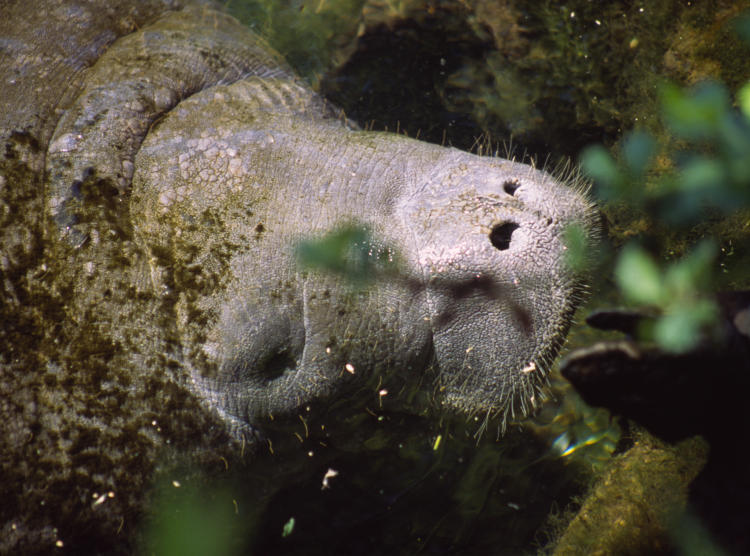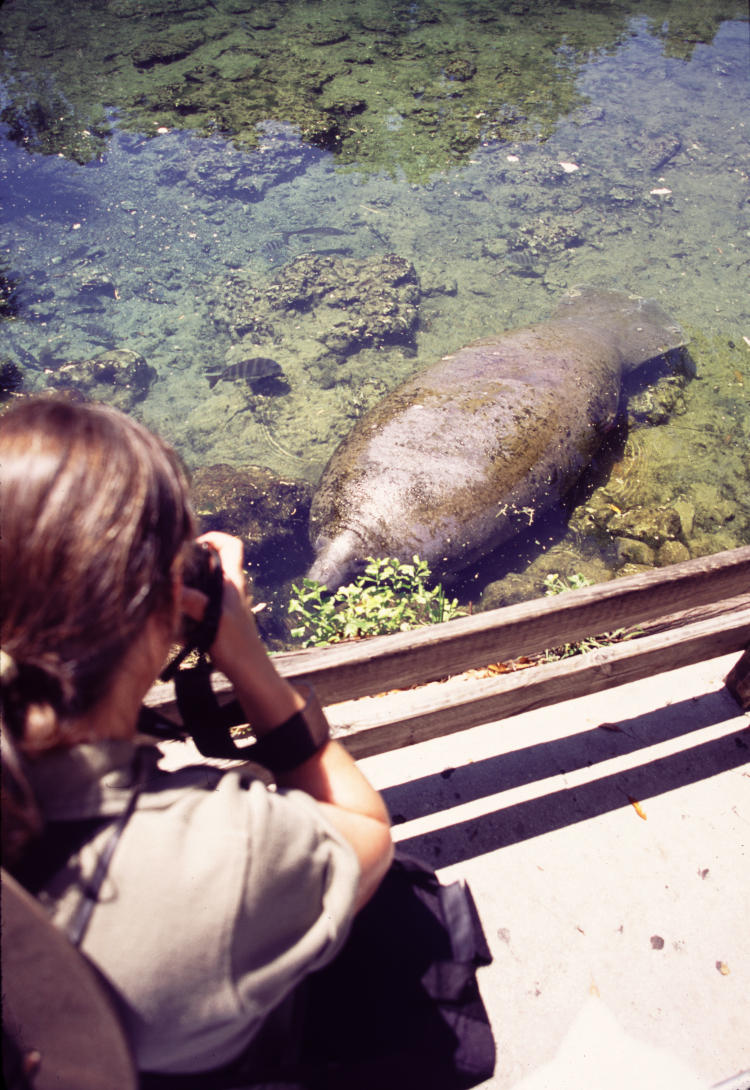
N 28°47’57.33″ W 82°35’16.94″ Google Earth location
This plot is as close as I can get it with the trees in the way, though if I was there again I could tell you within a half-meter. Not that it matters, because you might see something similar from many different spots, and anyway this particular model is likely not still waiting there.This is a North American manatee (Trichechus manatus,) or at least the head of one, found (easily) in Ellie Schiller Homosassa Springs Wildlife State Park, far too long of a proper name, in Homosassa Springs, Florida – the “Ellie Schiller” part has been added since The Girlfriend and I were there in 2009. We had been making our way south along the West/Gulf coast of Florida and had stopped in two locations previously to try and spot manatees; we’d actually been successful at the first, though it was from a distance without the best lighting and we saw what is typically seen, a snout peeking briefly above the water. This is so unprepossessing that it could easily be mistaken for a turtle, and if you look closely at the image here you can see the waterline around the nostrils that denotes what’s above and what’s below the surface.
But we hadn’t seen this yet, and were continuing on our path south when we suddenly passed the state park and decided to turn around and check it out. This was quite fortuitous since it is, among other things, a manatee rehabilitation center and one of Florida’s many warm springs, so the manatees were there in abundance, this one in particular coming right up along the shore under a viewing stand to await the scheduled feeding. Thus, captive, but about as close as you could possibly get, so if you want to see what a manatee really looks like, this is one of the better places, short of the tours at nearby locations where you’re allowed to snorkel with them. The Girlfriend doesn’t consider herself a nature photographer (I know, right?) but is more than happy to do so when the subjects are nearby and photogenic, while the definition of that word is stretched a bit when talking about manatees, just slightly above a formless blob and what I tend to call, “the beginnings of evolution.” Which isn’t true at all, and they used to be land mammals, but I can be cruel like that. I include, however, a shot of The Girlfriend getting her own shots, taken from the viewing bleachers in the same spot.

This is the visual of a story that I still tell, by the way, because The Girlfriend stood there motionless without snapping any frames for a while, and eventually I asked her what she was waiting for.
“I’m waiting for it to open its eyes,” she told me.
“They are open,” I replied, and they’re wide open in the top pic as well; manatees have quite small eyes for their bulk, and that’s as big as they’re gonna appear.
Now, some comments about the locale. The northern to central parts of Florida are riddled with warm springs; the geology is ‘porous,’ largely subterranean caves, that take the drainage from the swamps of southern Georgia and carry it underground until it pops up in various openings throughout Florida. Because they’re deep enough to be sheltered from surface temperatures, the water stays roughly the same temperature year-round, about 23°c – this is pleasantly cool in summer but nicely warm in winter, and thus the manatees love it, and will follow the channels up from the ocean to the spring sources in winter; despite their bulk, manatees can not handle colder temperatures. I say all this because the park sits directly over the mouth of one of these springs, and I mean directly: an underwater viewing area is suspended smack in the mouth of the spring. That’s the octagonal building with the pale green roof immediately west of the plot that I provided, and in those photos you can see the water darkening as the bottom (only a handful of meters deep until that spot) begins to drop off into the cavern system. As I type this, the aerial photos used in online Google Earth and the default in the program actually show manatees in the water. It’s easy enough to zoom out and follow the path of the springwater out to the nearby Gulf, and you’ll see the gate that keeps the injured or ill manatees within until they’re healthy enough to be released.
Ellie Schiller Homosassa Springs Wildlife State Park is also home to an education center and a small zoo, so definitely worth a stop. There’s a boat tour that you can take from the visitors’ center off of Rt 41 (you can follow that narrow, winding channel east from the plot too,) but you can also just drive over to the zoo area.
Two small side notes: the slide film I was using did not come up with a good color register, either from age or (more likely, since I kept my film refrigerated) a bad batch, so the colors have been improved here yet still suck. And North American manatees are also known as West Indian manatees, a name that I’m surprised is still in use; the “West Indies” is a relic of Christopher Columbus’ stupidity and “Indian” isn’t even considered appropriate for the indigenous people of North America. While I find a lot of the ‘Woke’ actions recently to be overreactive nonsense, anything related to the region being considered the ‘Indies’ should have vanished long ago.



















































